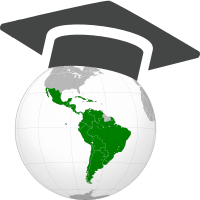Latin American Universities World Representation
How many Universities are there in Latin America? According to the uniRank database in 2024 there are currently 1,867 officially recognized higher-education institutions in Latin America. Considering that the uniRank database includes a total number of 14,013 officially recognized higher education institutions the proportion of Latin American Universities in the world is as follows:
-
uniRank Latin American Universities World Representation Index: 13.3%
Being the estimated population of the Latin American area around 8,6% of the total world population (source: United Nations' World Population Prospects, the 2015 Revision), the Latin American Higher education system and offerings seem to be moderately underrepresented in the world at least in terms of the number of higher education institutions.
Public vs Private Universities in Latin America
How many public and private Universities are there in Latin America? Out of the total number of 1,867 recognized higher education institutions in Latin America included in the uniRank database, 837 (44.8%) are public (i.e. officially affiliated to or run by national, state or local governments) and 984 (52.7%) are private. The type of control of the remaining Latin American Universities included in the uniRank database is unknown or it has not been reported (2.5%).
In terms of the number of public versus private Universities, the uniRank database shows a moderate balance between public versus private higher education in the Latin American area as a whole. However, 127 (63.5%) out of the top 200 Universities in Latin America are public higher education institutions. Differences and peculiarities may still exist in each Latin American country's higher education system.
Non-profit vs for-profit Universities in Latin America
What type of entities are Universities in Latin America? Out of the total number of 1,867 recognized higher education institutions in Latin America included in the uniRank database, 1,215 (65.1%) are non-profit and 77 (4.1%) are for-profit. The type of entity of the remaining Latin American Universities included in the uniRank database is unknown or it has not been reported (30.8%). As a general rule, the vast majority of Latin American public higher education institutions are not-for-profit organizations, not necessarily in legal terms but certainly in terms of nature and institutional purposes such as role, scope and mission.
Challenges for the higher education systems in Latin America
What are the main challenges that higher education in Latin America currently faces? According to uniRank the main issues of the higher education systems in Latin America include:
a) Access and affordability: access to higher education is still a challenge in many Latin American countries, with many students from disadvantaged backgrounds unable to afford the high cost of tuition fees. This limits the number of students who can access higher education, leading to a lack of skilled professionals in the workforce. Social inequality is a major challenge in Latin America, and this is reflected in the higher education system. Students from disadvantaged backgrounds often struggle to access higher education and those who do often face discrimination and a lack of support. This perpetuates social inequality and limits the potential of the region.
b) Funding: universities in Latin America often suffer from a lack of funding, which makes it difficult for them to invest in research and improve their infrastructure. This, in turn, affects the quality of education they can offer.
c) Research and Innovation: low research output and innovation in Latin America.
d) Technology: technology is rapidly transforming the higher education landscape and universities need to keep up with the latest trends to remain relevant. This includes adopting new teaching methods, online learning platforms and other digital technologies.
e) Employability and relevance: the curriculum in many Latin American universities often does not match the needs of the job market, leading to a skills mismatch between graduates and employers. This is a particular challenge in the rapidly changing global economy, where new skills and knowledge are constantly required.
f) Brain drain: Latin American universities often struggle to retain their best students and faculty, who are attracted by better opportunities and higher salaries in other countries. This leads to a loss of talent and knowledge, which can be detrimental to the development of the region.
g) Harmonization: lack of harmonization of the higher education systems in Latin America.
h) Political instability: political instability is a major challenge for higher education in Latin America, with frequent changes in government leading to changes in education policies and funding. This makes it difficult for universities to plan for the long term and invest in the future.
Addressing the above challenges will require collaboration between Latin American governments, higher education institutions, employers and other stakeholders. Some potential solutions include increasing funding for financial aid programs, fostering technology in education, encouraging collaboration, funding and a supportive culture for research and innovation and enhancing the alignment between higher education and workforce needs.
Top 200 Universities in Latin America
uniRank publishes twice a year a non-academic university ranking of the top 200 Universities in Latin America based on valid, unbiased and non-influenceable web metrics provided by independent web intelligence sources. Please read the ranking methodology on the About Us page for more information.

 Anguilla
Anguilla